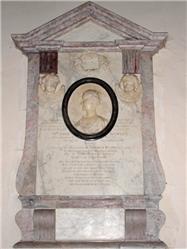It is thought that the font, which is close to the entrance, was originally a 'capital' in the abbey. If you look beneath the rim, you will see the face of the ‘green man’, with animals issuing from his mouth. This type of carving is thought to relate to pagan times. The stone angels above the 'green man' are poised in opposition and in protective attitude, demonstrating that paganism has been overcome. Behind the font is the west window, which may at one time have been a processional door.
As you walk down the north aisle towards the east, look up and note the cuts which severed the stone heads at the time, perhaps, of the Civil War. The memorial brasses on the north wall are to two members of the Martyn family who lived in Eynsham in the 16th century, and one inscribed to the memory of a long-serving Elizabethan vicar, William Emmott. The wall memorial above the pulpit is to members of the Knight family who were closely connected to Jane Austen.
The wooden pulpit is Jacobean, its stone base has replaced a slim wooden pillar which unfortunately collapsed; the prayer desk near the pulpit has a carved ‘poppyhead’ decoration of the 15th century.
The chancel was built in the 14th century and was originally ornamented with coloured murals. Only one area, to the left of the communion table, on the north wall, remains and is in need of cleaning. The niche to the left of the altar, which woold once have housed a figure of the Virgin Mary, contains a representation of St Leonard, the patron saint of prisoners, carved by Gwynneth Gordon (née Holt) in 1982 from one block of limewood.
To the right of the Communion table is the tomb of Sir Edward Stanley. The Stanleys were given possession of the abbey at the dissolution of the monasteries by Henry VIII. Sir Edward was a grandson of the Earl of Derby and some people still argue that he was the true Shakespeare. The parish church at Tong in Staffordshire also has the tomb of Sir Edward, and there is some lively speculation as to what lies where.
The lovely east window replaced an Early English one, and was designed by John Wilkins at the beginning of this century as a memorial to Dr Smallhorn, the village physician: Its design shows the influence of the Pre-Raphaelite school and the saints pictured at the top of the window represent (from left to right), St Leonard, St Stephen, St Alban and St Augustine.
In the south wall of the chancel is a graceful piscina and a priest's door. The attractive small archway to the south aisle was once the entrance to stairs behind the rood screen. In the abbey cartulary there is a reference to ‘the light in the chapel of St Leonard’ and the south aisle is presumed to be that original chapel: It is of the 12th century and has ancient communion niches (piscine and aumbry) and in the south wall close by are two Early English windows. Look up to see the mediaeval stone heads which have been preserved in this aisle. The last of the church mediaeval pews was reconstructed and stands in the south aisle near the organ. It bears a piece of the old rood screen, as also does the wooden communion table, once the main altar, which is thought to be of 17th century origin (the legs are a 19th century addition).
 On the south wall there are three memorials to the Rogers family. Beginning with the memorial close to the churchyard door, this was erected to the memory of the Reverend John Rogers, vicar of Eynsham from the Restoration of the monarchy in 1664 until 1714, and to his wife, Anne. Their granddaughter, Anne Bedwell, is commemorated on the middle memorial. One historian (Mrs Esdaile) noted this monument as a 'pretty' portrait medallion and it is also mentioned in Pevsner’s ‘The Buildings of England’.
On the south wall there are three memorials to the Rogers family. Beginning with the memorial close to the churchyard door, this was erected to the memory of the Reverend John Rogers, vicar of Eynsham from the Restoration of the monarchy in 1664 until 1714, and to his wife, Anne. Their granddaughter, Anne Bedwell, is commemorated on the middle memorial. One historian (Mrs Esdaile) noted this monument as a 'pretty' portrait medallion and it is also mentioned in Pevsner’s ‘The Buildings of England’.
The third memorial is inscribed to the Reverend John Rogers, DD, Canon and Sub-Dean of Wells Cathedral, Vicar of Cripplegate, London, and chaplain to the young George 11.
The lovely Perpendicular doorway leads to the churchyard where the outer wall buttresses of the south aisle bear ‘scratch’ dials, an early type of sundial.
From the end of the churchyard there is a pleasant view of the Thames valley. This area of abbey and church has been a sacred site since before the Conquest, and archaeological investigation has revealed that it was once a Bronze Age enclosure.
Our church with its graceful tall pillars and clear light was built for the people of Eynsham by the abbey authorities. It is a powerful reminder of the wonderful talents of our ancestors and of the joyful faith which inspired those craftsmen and which inspires us today.
JW, 1997